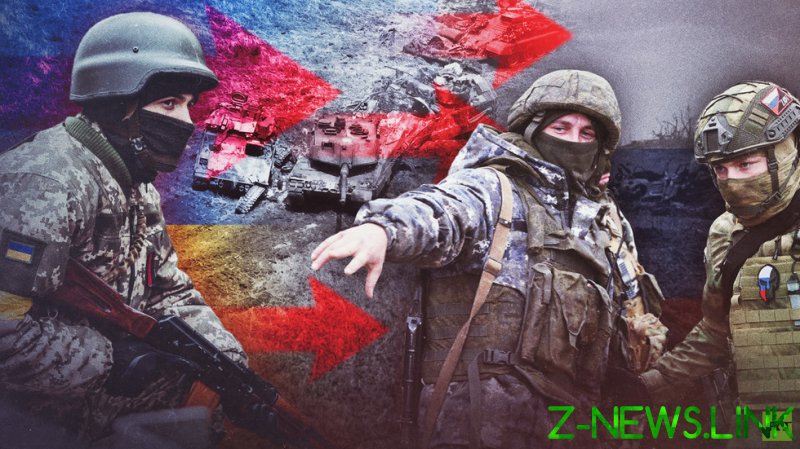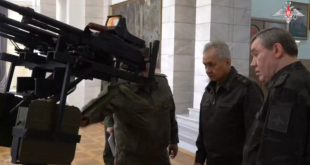
The counteroffensive of the Armed Forces of Ukraine (AFU), widely hyped by Ukrainian and Western officials since the beginning of the year, has been going on for nearly a month. Since June 4, Kiev’s forces have been trying to advance on the southern section of the frontlines in Zaporozhye Region and in the western part of the Donetsk People’s Republic (DPR).
The anticipated ‘blitzkrieg’ strategy was not successful and the Ukrainian offensive became stuck in positional warfare, losing a lot of the military equipment provided to it by the West. By the end of June, Kiev managed to occupy a mere eight villages, but was not able to reach the main Russian fortifications.
Kiev and its Western partners are now particularly concerned about the planned breakthrough to the Sea of Azov, since the strategic goals of the counteroffensive have failed and the land corridor to Crimea remains under Russian control. So why has Ukraine’s much-hyped operation failed?
How was the current front line formed?
The front line in Zaporozhye Region and the western part of the DPR was formed in the spring of 2022. At that time, Russian troops were able to merge their Crimean units, which captured the cities of Tokmak and Pologi, with the Donbass units to form the ‘Mariupol cauldron’.
Meanwhile, the Russian Army’s attempts to move closer to Zaporozhye and capture the cities of Gulyai-Pole and Orekhov – the AFU’s main strongholds in Zaporozhye Region – were not successful.
To the east, in the area of the Vremyevsky salient, active battles continued until the summer of 2022. On July 14, the DPR territorial defense headquarters confirmed the capture of Neskuchny village south of Vremyevka – the last settlement liberated by the People’s Militia of the DPR in this section of the front.
The strategic importance of this section of the front
Even though the Russian Army did not get to Zaporozhye or flank the AFU’s positions in Donbass, the military achievements of last spring and summer were extremely important for Russia.
Firstly, Moscow took control of the Crimea-Melitopol-Berdiansk-Mariupol-Rostovskaya highway where the automobile bridge to the Crimea is located. As a result of these efforts, the peninsula became better connected with mainland Russia.
Secondly, control over these territories created a buffer zone around Crimea and forced the Ukrainians to retreat from the Sea of Azov, which became completely Russian territory. Also, Moscow was able to build a single front from the mouth of the Dnieper River to the Russian border (as it was in the summer of last year).
This positioning, however, also came with certain vulnerabilities for the Russian troops. If the Ukrainian offensive had been successful and the AFU had broken through to the Sea of Azov, the Russian front would have split into two parts. However complex, the attempt was worth it for Ukraine, since the AFU could have then blocked the Russian Army’s Donbass units and posed a serious threat to Crimea and Sevastopol – the Black Sea Fleet’s main military base.
From offense to defense
Understanding the strategic importance of the area, Russia began transferring units there, which sometimes resulted in losses at other sections of the front. For example, the 35th combined arms army was pulled out of Izium, which contributed to Russia’s retreat from Kharkov Region in September 2022.
From there, the Armed Forces of the Russian Federation built a deep line of defense, a task which involved civilian workers. Near Melitopol, it constructed a defense line in two echelons with a forefield and two security zones. Tokmak and the village of Ocherevatoye were prepared for point defense.
Assessing Russia’s defense measures in this area, it’s possible to say that even if the AFU managed to break this line of defense, they would still face many difficulties. Trained Russian reserves would have deployed a counteroffensive and attacked the flanks of the AFU from Kherson Region and the DPR. The terrain would work in favor of the Russian Army – among other things, the troops would rely on Zaporozhye Region’s highest points near Kamysh-Zarya and Rozovka.
Finally, even with the best fortifications, an effective line of defense is impossible without motivated and trained soldiers working side by side with the artillery, intelligence, and aviation. Therefore, the elite units of the 58th Army’s 42nd Motor Rifle Division were placed at the forefront of Russia’s defense in the strategically important Melitopol direction.
Public and media expectations
The Western press was very excited about the AFU’s prospects in Zaporozhye Region. For example, US military “expert” John Deni said the Ukrainians would make use of Western military equipment to easily defeat Russia in their counteroffensive.
The expected battles were presented by the media as a decisive point of the war. This media positioning unsettled the Ukrainian leadership, forcing them to justify the delayed start of the operation and request silence on the matter. However, this situation only unnerved Ukrainian officials, while Ukrainian society, inspired by Western military aid and the numerous promises of politicians, looked forward to imminent success.
In Russia, however, an opposite situation was brewing. Russian society had still not fully recovered from the reversals in Kharkov Region and the retreat from Kherson, taking these events as signs that the military operation was running counter to its original goals. These opinions were pushed by certain people who were politically motivated to criticize the Russian military leadership. Even the victory in Artyomovsk (known as Bakhmut in Ukraine) did not fully raise public morale – many people attributed this success solely to the efforts of the Wagner private military company, and not the regular Russian Army, which would be responsible for blocking Ukraine’s counteroffensive. As a result, Russian society was concerned about the AFU’s forthcoming strike which, in case of success, would increase apathy among Russians and contribute to further demoralization.
Ukraine deploys new brigades
The AFU was expected to involve newly-formed units in the counteroffensive, mostly armed with Western weapons and trained by Western instructors. These brigades were kept in the rear for a long time. Only some units (such as the 46th and 77th brigades formed in the summer) were sent to Artyomovsk where they demonstrated quite effective results.
Other brigades proceeded with their training, taking advantage of the time bought by the blood of the ‘older’ units. For example, the 79th Brigade fought for Maryinka, a suburb of Donetsk, for a year and a half without being rotated. Instead of sending new units over to replace them, the Ukrainian leadership has continued to exploit the fighters to this day.
All this was done in order to keep the fresh units strong and ready for the counteroffensive against Russia. Ukraine hoped that the new brigades would ensure its victorious march to the Sea of Azov, and this would mean not only the victory of Kiev over Moscow, but also the triumph of Western weapons and military training. However, these hopes did not materialize.
The Vremyevsky salient – the most vulnerable section of defense
On June 4, Ukraine launched its counteroffensive with a distracting (later to become the main) strike on the Vremyevsky salient. Apparently, this was intended to pull out the Russian Army’s reserves and draw them into battle in this area. These attacks continued for several days but were unsuccessful.
During the second attack on June 10, Ukraine’s army acted more effectively, and by June 13, Russia retreated from the villages of Novodarovka, Neskuchnoye, Storozhevoye, Blagodatnoye, and Makarovka. On June 26, the Ukrainians took control of Rovnopol and some positions in the fields on the way to Novodonetsky and Priyutnoye.
In the course of three weeks of fighting, the AFU captured six villages, which were all evacuated ahead of time. It should be noted that the Vryemyevsky salient was initially extremely inconvenient for Russian defense – surrounded by Ukrainian forces from the flanks, it also had the Mokriye Yaly River flowing through the center of Russian positions. As a result, Moscow’s forces could rely only on several heights on the flanks.
However, even with the terrain acting in its favor, the AFU did not achieve much success. The insignificant advance came at a great price – Western equipment was destroyed and indirect data shows that the enemy suffered significant casualties. Nevertheless, Kiev’s breakthrough attempts continue. Presently, the AFU is stuck against Russian defenses in Staromayorsky and Urozhaynoye, and hopes to outflank them, which only brings them closer to more fortified positions.
‘Safari’ near Orekhov and Ukraine’s media defeat
On June 7, the AFU started moving in the direction of Melitopol. Initially, this was the task of the 128th Mountain Assault Brigade, a unit which had earlier suffered many casualties. Going in the direction of Vasilevka, the brigade tried to occupy the village of Lobkovo.
The next day, the AFU launched an offensive supposedly headed by the 47th Mechanized Brigade and armed with the new German Leopard tanks. This attack ended badly for the Ukrainians – the operation failed, Western equipment was destroyed, and Russia published damaging video footage which went viral online.
The Ukrainian online resource DeepState, which shows a live map of the war, temporarily closed the comments section and later published an “uncomfortable analysis” of the events, slamming Ukrainian officials and politicians who claimed that their army had not launched a counteroffensive yet. According to Ukrainian political observers, the behavior of the officials devalued the lives of the country’s soldiers.
On June 10, the mounting pressure forced Ukrainian President Vladimir Zelensky to confirm the start of the counteroffensive and the losses, long before having any newsworthy success to demonstrate to the public. Ukraine’s strategy usually involved keeping its actions secret until the public and the press could be presented with attractive evidence of Ukrainian victories. This time, however, the footage of scorched Leopards forced Ukraine to break the rule.
Ongoing battles south of Orekhov
Subsequently, Ukraine managed to achieve certain success in this direction. Increased pressure on the front forced the Russian Army to retreat from two other villages – Lobkovoe and Pyatikhatka, where lengthy battles took place. Presently, the Russian Army is holding its defensive positions near the village of Zherebyanka.
To the east, the AFU was able to advance through the fields in the direction of the village of Rabotino, which is on the road from Orekhov to Tokmak. Both sides have suffered losses but Ukraine is also losing a vital asset – time – as the pace of the counteroffensive slows down.
Moreover, the Russian Air Force is constantly attacking UFU warehouses and staging areas. All this increases the costs of the counteroffensive and makes the Ukrainian Army’s ultimate success even less likely.
Ukraine’s broken hopes for a fast-paced war
The series of defeats has disappointed Ukrainian society, which was counting on a fast-paced operation and a breakthrough on the front. Every two weeks, Ukrainian journalist Roman Shrike polls his Telegram subscribers on the estimated duration of the war. On June 15, the option that the war will continue for ‘more than another year’ received over 50% of votes for the first time.
Propagandist Aleksey Arestovich noted that Ukraine’s success in Kharkov Region is an exception to the rule and cannot be repeated over and over again. He described the fighting in Zaporozhye Region as “a bloody fight accompanied by losses on both sides”. In order for Ukraine’s next offensive to be more successful, Arestovich says the country needs Western planes.
Meanwhile, ordinary Ukrainians, some of whom were forced to become refugees while others lost their jobs or were forcibly conscripted, see that the current situation – in which the country is growing poorer by the day and people risk danger daily – can last for many more years.
All this greatly strains society, which sees no quick victory ahead. At the same time, several cities, including a major part of Kiev, have announced a general mobilization on behalf of their regional councils. General mobilization in Ukraine has already been in effect since February 24, 2022, but these new statements demonstrate a new desperation. Of particular concern is the order for everyone liable for military duty to come to military enlistment offices, regardless of whether they have personally received a summons.
Western pressure meant that Zelensky was obliged to make a move, in the full knowledge that his hand was weak. Thus, he was like a chess player faced with a Zugzwang.
By Vladislav Ugolny, a Russian journalist born in Donetsk
© 2023, paradox. All rights reserved.





